Businesses come from great ideas, but there’s more behind starting a company than an innovative concept. A solid business plan sets the foundation for a solid company. It’s the comprehensive roadmap for structuring, running, and even growing a new business. It helps entrepreneurs think through critical elements at each stage of launching their businesses.
Business plans are crucial to the financial success of a new business. A well-thought-out plan can help acquire funding and attract experienced business partners as it outlines how your business will generate enough profit to earn a decent return on investment for investors.
Nerd Wallet describes a strong, detailed business plan as a tool that can convince others your company is a smart choice for them. If you have a bright idea and you’re heading down the business route, now’s the time to learn how to write a successful business plan. Read on for tips and resources to help you write the model plan.
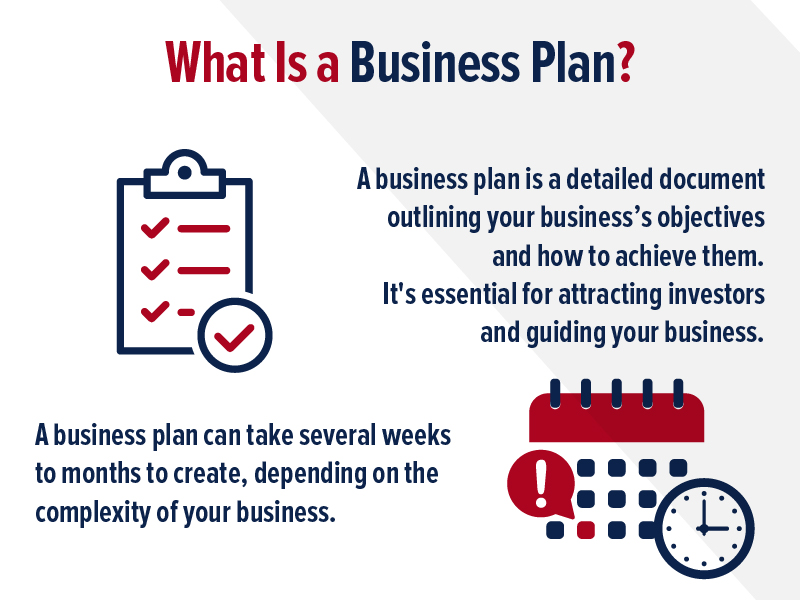
What Is a Business Plan?
A business plan is a formal document (about 15–25 pages in length) that precisely defines a company’s objectives in fine detail. It also describes how the company plans to achieve its goals. All companies — including startups and established institutions — create and use business plans.
Comprehensive, carefully thought-out business plans are critical for new businesses to attract investors and secure lending, however; a business plan can also serve an established company. It can keep the executive team on the same page regarding strategic actions and on-task for meeting established goals. A business plan can be periodically reviewed and updated, and new ones can be created if a business decides to move in a new direction.
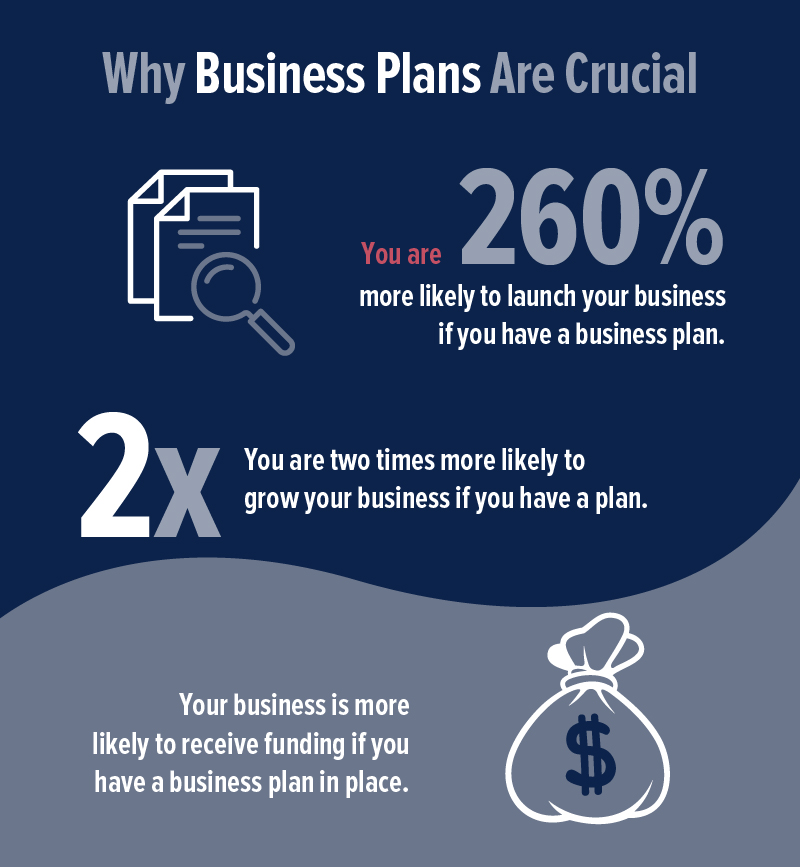
Seven Elements of a Business Plan
According to Investopida.com and Nerd Wallet, most business plan templates include seven elements: an executive summary, company description, products and services, market analysis, marketing strategy, financials, and budget. You will also want to include an appendix that contains data supporting the main sections. You don’t have to follow a specific outline or template. Instead, include sections that make the most sense for your business and its needs.
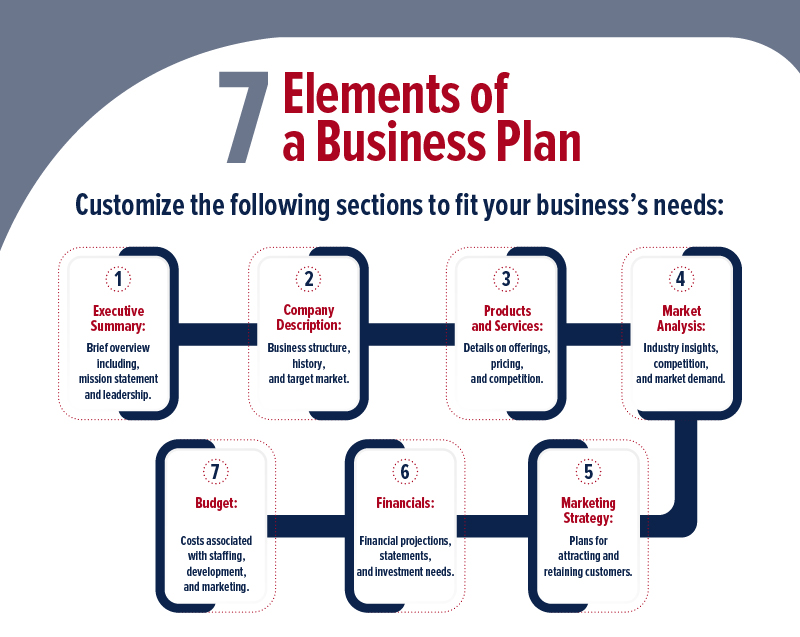
No two business plans are the same, but they should include these seven key elements:
- Executive summary: This section details the business and what it wants to accomplish. It includes the mission statement and information about the leadership, employees, operations, and location.
- Company description: This overviews the business’s plan and vision. It should include the company’s name, business structure, and an overview of the target market. As Forbes notes, the company description should state whether the business is a sole proprietorship, Limited Liability Company (LLC), partnership, or corporation. It should also include a section that outlines the company’s history and evolution.
- Products and services: This section details the products and services offered. It can include pricing, product lifespan, benefits, and similar products and competitors. You want to show the difference between your product or service and how it will rise above the competition. Other topics in the section can include production and manufacturing processes, research and development, company patents, and proprietary technology.
- Market analysis: A business needs to understand its industry and target market. The market analysis details the competition and plans on how to differentiate. It also explains how the company fits in with the industry and details its strengths and weaknesses. This section details the target market and the expected consumer demand for the product or service. Research should also show how easy or difficult it will be to grab market shares (the percentage of total sales generated by the company that is calculated by taking the company’s sales over a period and dividing them by the industry’s total sales over the same period).
- Marketing strategy: This part explains how the company plans to attract and retain customers, it outlines a clear distribution channel, and defines planned advertising and marketing strategies. It can also describe the types of media used for those strategies and campaigns.
- Financials: A business plan should include a company’s financial planning and projections. For an established business, this includes financial statements, balance sheets, and other documents. New businesses can include targets and estimates for the first few years of operation. It can also outline the company’s potential investors and what financial assistance the company may need.
- Budget: Every business needs a budget, so every business plan should detail staffing, development, manufacturing, and marketing costs.
Again, since all businesses are different, all business plans are different. The best business plans entice readers with information that demonstrates why that business should be in operation.
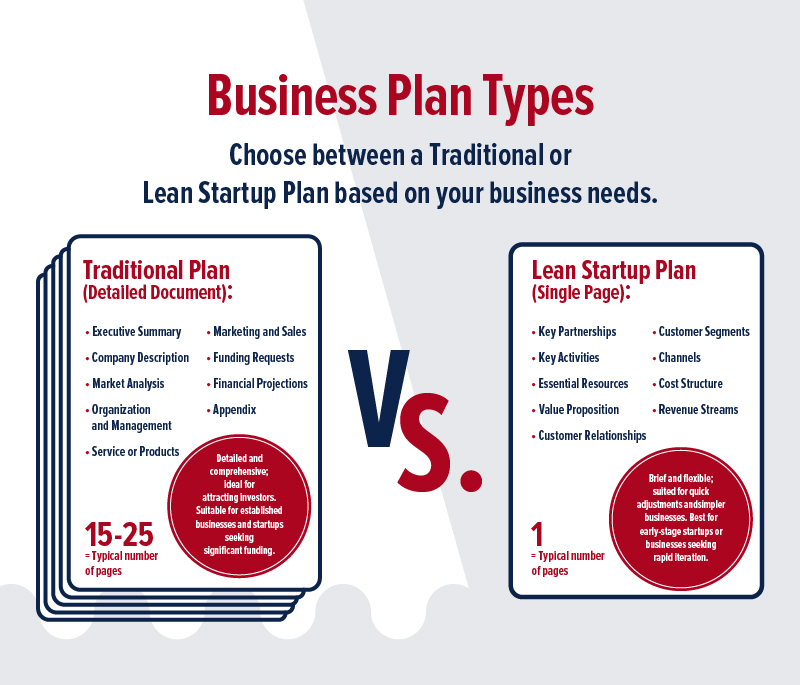
Business Plans – Traditional or Lean Startup?
As mentioned above, there is no right or wrong business plan, but they typically fall into two categories: traditional or lean startup.
According to the Small Business Administration (SBA), a traditional business plan is the most common. It is very detailed, takes a fair amount of time to create, and is comprehensive. Also, lenders and investors commonly request this type of plan.
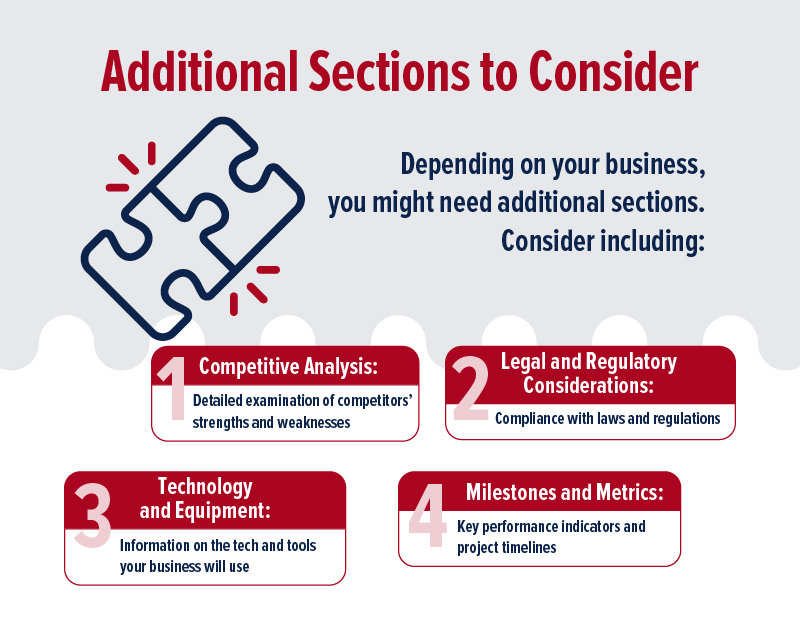
Traditional business plans use some combination of these nine sections:
- Executive summary
- Company description
- Market analysis
- Organization and management
- Service or products
- Marketing and sales
- Funding requests
- Financial projections
- Appendix
Traditional business plans use a standard structure and encourage more details in every section. Established businesses can create traditional business plans because they have the data and research to back up each section. Startups can also use a traditional business plan and provide similar data to predict their success. The more data the better — even if it isn’t from the business in the plan — because it can attract investors.
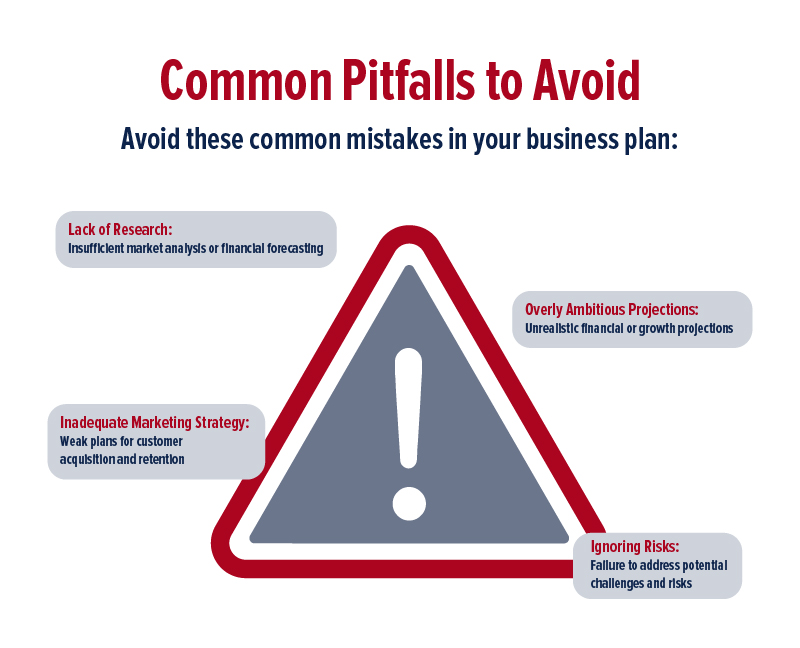
A lean startup business plan, on the other hand, is rare. It focuses on summarizing the essential points of and critical elements of the plan. These plans are typically a single page, are not as detailed, and don’t take much time to create. You should be prepared to provide more details and research if later requested by an investor or lender. A lean startup business plan is ideal if you want to explain or start your business quickly, if your business is relatively simple, or if you plan to refine the business plan regularly.
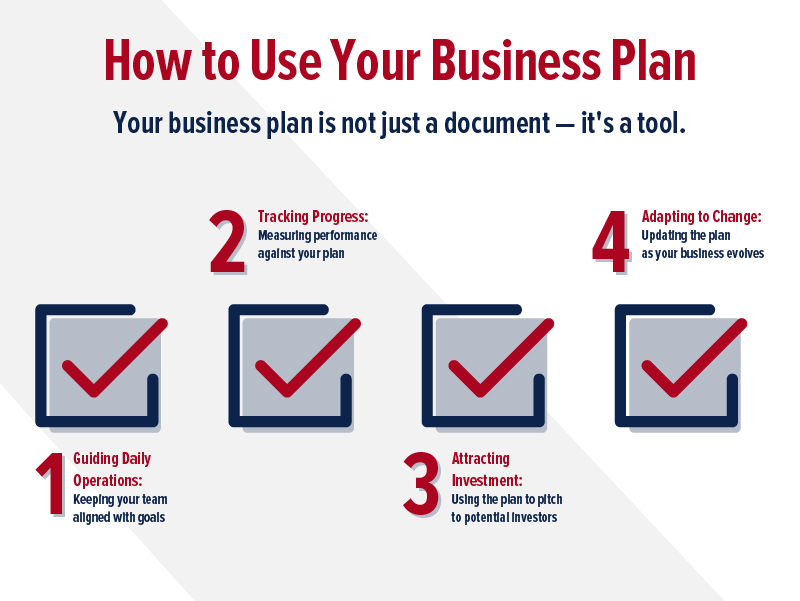
Like traditional plans, there are different formats for a lean startup plan. According to the SBA, these are the fundamentals for a lean business plan:
- Key partnerships: These are the other businesses or services that will help run the business, including suppliers, manufacturers, subcontractors, and similar strategic partners.
- Key activities: This section lists how the business will differentiate and have a competitive advantage.
- Essential resources: List any resources the company will leverage to create added value for the customer.
- Value proposition: This statement describes the company’s unique value and what it brings to the market.
- Customer relationships: This section describes how customers will interact with the business and details the customer experience from start to finish.
- Customer segments: This is where the target markets are named. Investors will want a clear sense of the types of customers the business will serve.
- Channels: Here is a list of how the business will use various forms of media to interact with customers.
- Cost structure: Here, the cost strategy is defined, with a focus on the highest costs the business is facing.
- Revenue streams: This is where the plan states how the business will make money. All revenue streams should be listed.
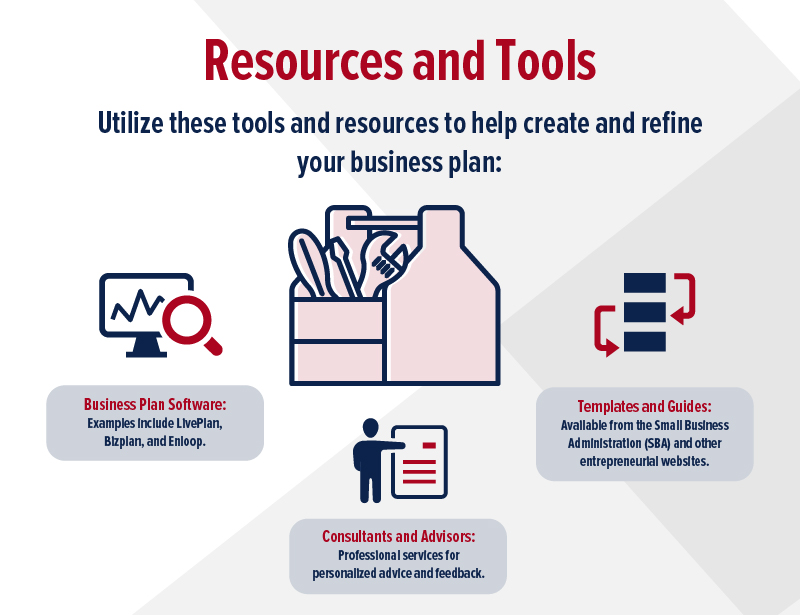
Every business starts with a vision and a mission, and either a traditional or lean startup business plan can help communicate those details. A strong business plan will outline short-term and long-term goals.
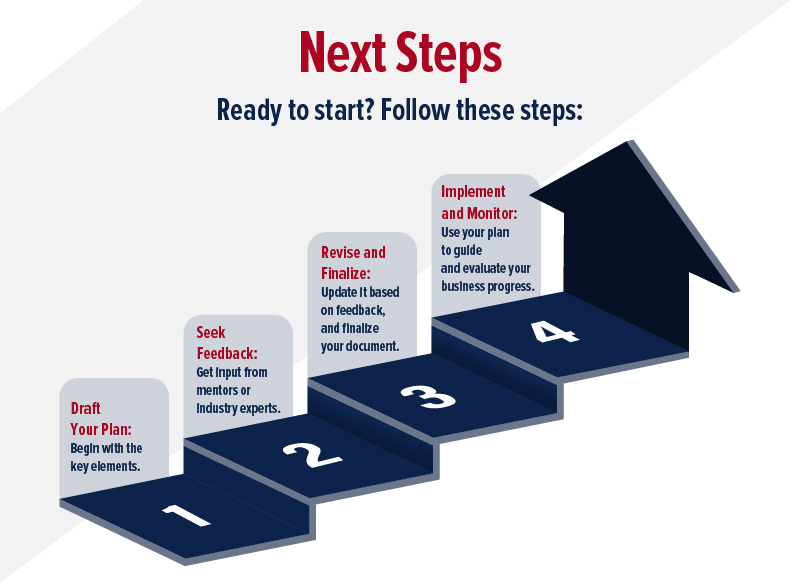
Overview: How To Write a Business Plan
A business plan is the roadmap and the foundation of any business, and though all plans aren’t the same, they should all have similar areas of focus. Different business plans are essential for companies of all sizes and in various stages of experience. They define where a business is and where it wants to go. They require a thought-out vision if you wish for your business to succeed.
How to Write a Business Plan Infographic

--
